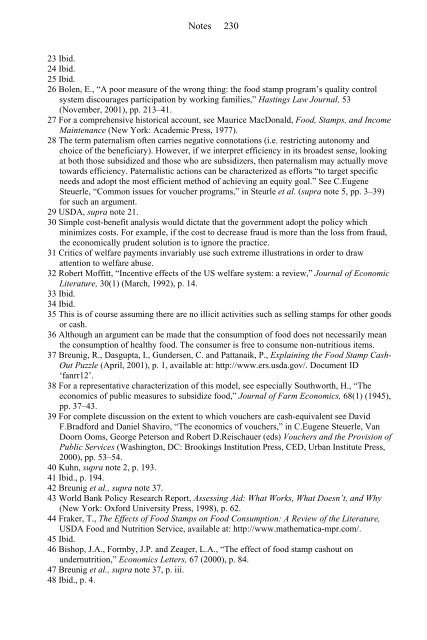Rethinking the Welfare State: The prospects for ... - e-Library
Rethinking the Welfare State: The prospects for ... - e-Library
Rethinking the Welfare State: The prospects for ... - e-Library
You also want an ePaper? Increase the reach of your titles
YUMPU automatically turns print PDFs into web optimized ePapers that Google loves.
Notes 230<br />
23 Ibid.<br />
24 Ibid.<br />
25 Ibid.<br />
26 Bolen, E., “A poor measure of <strong>the</strong> wrong thing: <strong>the</strong> food stamp program’s quality control<br />
system discourages participation by working families,” Hastings Law Journal, 53<br />
(November, 2001), pp. 213–41.<br />
27 For a comprehensive historical account, see Maurice MacDonald, Food, Stamps, and Income<br />
Maintenance (New York: Academic Press, 1977).<br />
28 <strong>The</strong> term paternalism often carries negative connotations (i.e. restricting autonomy and<br />
choice of <strong>the</strong> beneficiary). However, if we interpret efficiency in its broadest sense, looking<br />
at both those subsidized and those who are subsidizers, <strong>the</strong>n paternalism may actually move<br />
towards efficiency. Paternalistic actions can be characterized as ef<strong>for</strong>ts “to target specific<br />
needs and adopt <strong>the</strong> most efficient method of achieving an equity goal.” See C.Eugene<br />
Steuerle, “Common issues <strong>for</strong> voucher programs,” in Steurle et al. (supra note 5, pp. 3–39)<br />
<strong>for</strong> such an argument.<br />
29 USDA, supra note 21.<br />
30 Simple cost-benefit analysis would dictate that <strong>the</strong> government adopt <strong>the</strong> policy which<br />
minimizes costs. For example, if <strong>the</strong> cost to decrease fraud is more than <strong>the</strong> loss from fraud,<br />
<strong>the</strong> economically prudent solution is to ignore <strong>the</strong> practice.<br />
31 Critics of welfare payments invariably use such extreme illustrations in order to draw<br />
attention to welfare abuse.<br />
32 Robert Moffitt, “Incentive effects of <strong>the</strong> US welfare system: a review,” Journal of Economic<br />
Literature, 30(1) (March, 1992), p. 14.<br />
33 Ibid.<br />
34 Ibid.<br />
35 This is of course assuming <strong>the</strong>re are no illicit activities such as selling stamps <strong>for</strong> o<strong>the</strong>r goods<br />
or cash.<br />
36 Although an argument can be made that <strong>the</strong> consumption of food does not necessarily mean<br />
<strong>the</strong> consumption of healthy food. <strong>The</strong> consumer is free to consume non-nutritious items.<br />
37 Breunig, R., Dasgupta, I., Gundersen, C. and Pattanaik, P., Explaining <strong>the</strong> Food Stamp Cash-<br />
Out Puzzle (April, 2001), p. 1, available at: http://www.ers.usda.gov/. Document ID<br />
‘fanrr12’.<br />
38 For a representative characterization of this model, see especially Southworth, H., “<strong>The</strong><br />
economics of public measures to subsidize food,” Journal of Farm Economics, 68(1) (1945),<br />
pp. 37–43.<br />
39 For complete discussion on <strong>the</strong> extent to which vouchers are cash-equivalent see David<br />
F.Brad<strong>for</strong>d and Daniel Shaviro, “<strong>The</strong> economics of vouchers,” in C.Eugene Steuerle, Van<br />
Doorn Ooms, George Peterson and Robert D.Reischauer (eds) Vouchers and <strong>the</strong> Provision of<br />
Public Services (Washington, DC: Brookings Institution Press, CED, Urban Institute Press,<br />
2000), pp. 53–54.<br />
40 Kuhn, supra note 2, p. 193.<br />
41 Ibid., p. 194.<br />
42 Breunig et al., supra note 37.<br />
43 World Bank Policy Research Report, Assessing Aid: What Works, What Doesn’t, and Why<br />
(New York: Ox<strong>for</strong>d University Press, 1998), p. 62.<br />
44 Fraker, T., <strong>The</strong> Effects of Food Stamps on Food Consumption: A Review of <strong>the</strong> Literature,<br />
USDA Food and Nutrition Service, available at: http://www.ma<strong>the</strong>matica-mpr.com/.<br />
45 Ibid.<br />
46 Bishop, J.A., Formby, J.P. and Zeager, L.A., “<strong>The</strong> effect of food stamp cashout on<br />
undernutrition,” Economics Letters, 67 (2000), p. 84.<br />
47 Breunig et al., supra note 37, p. iii.<br />
48 Ibid., p. 4.


